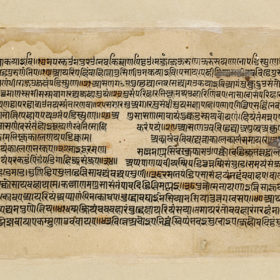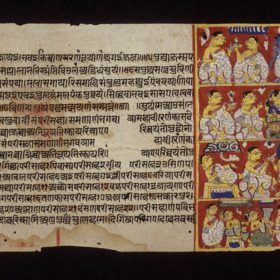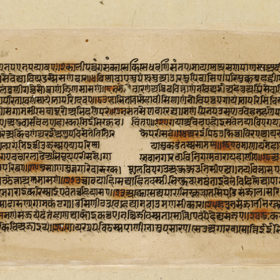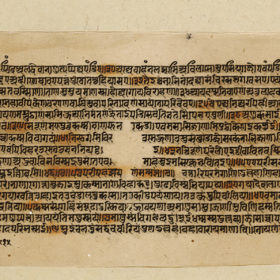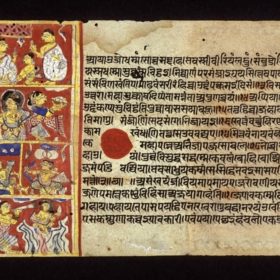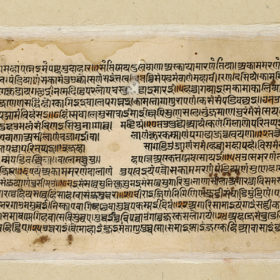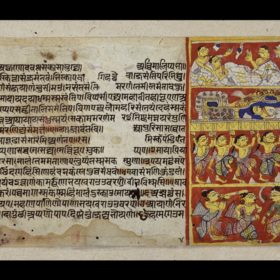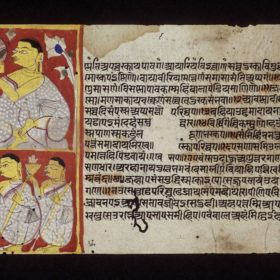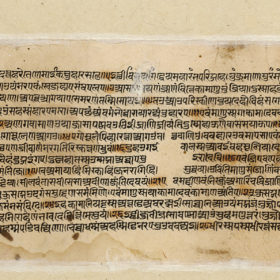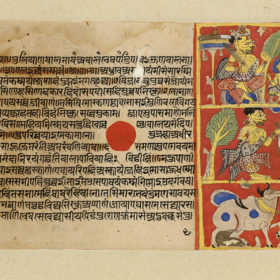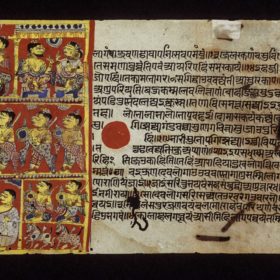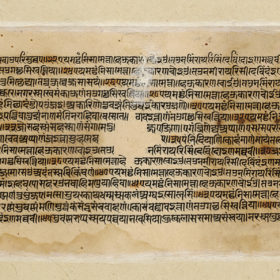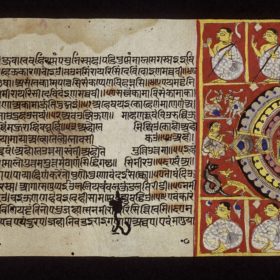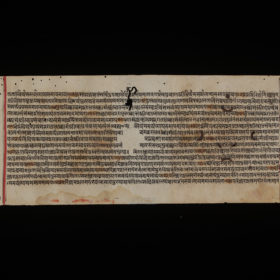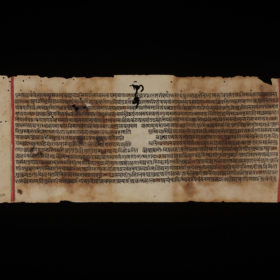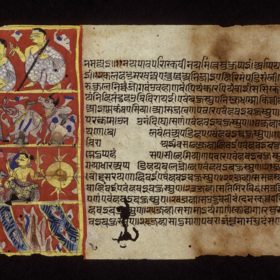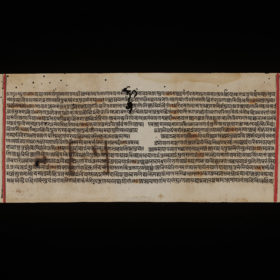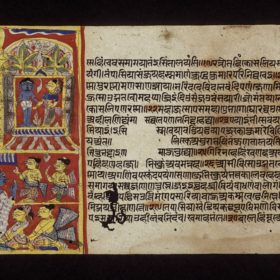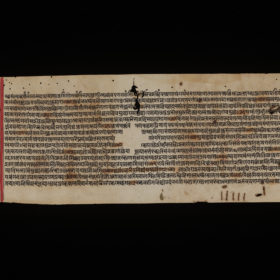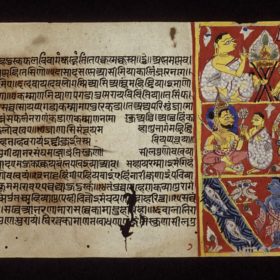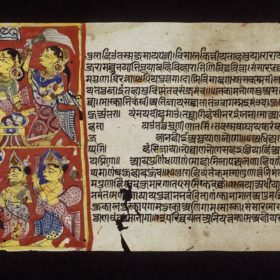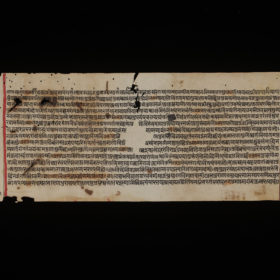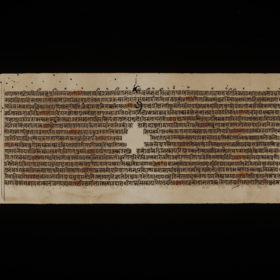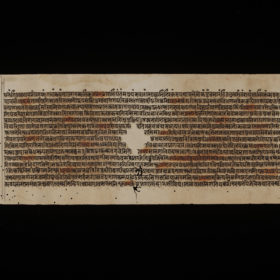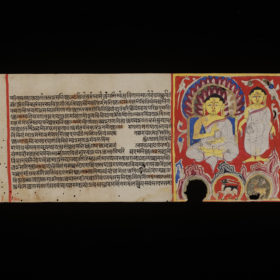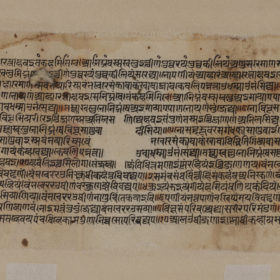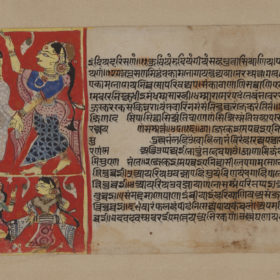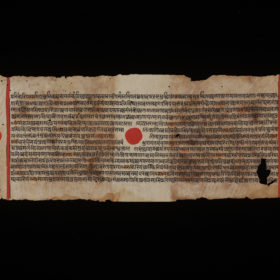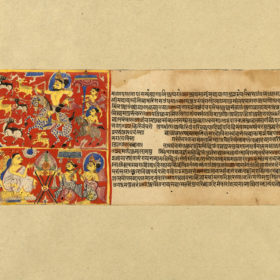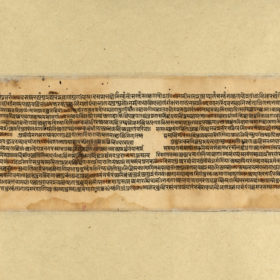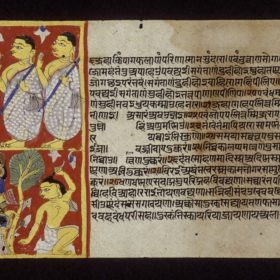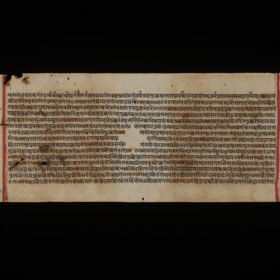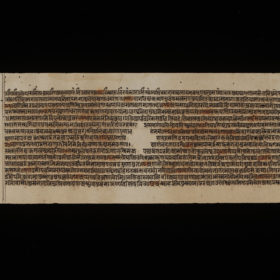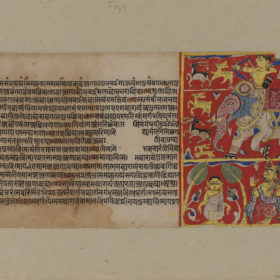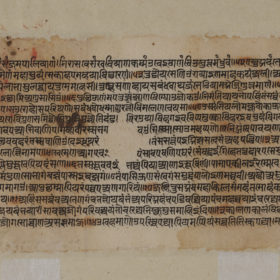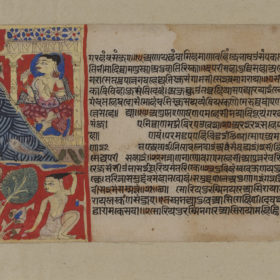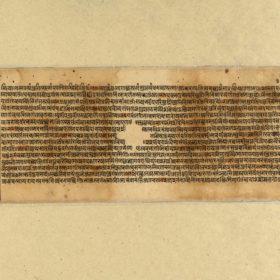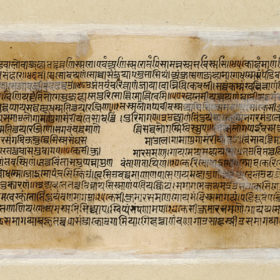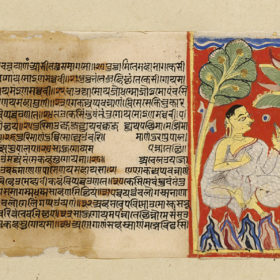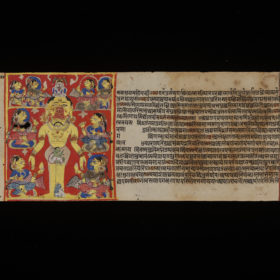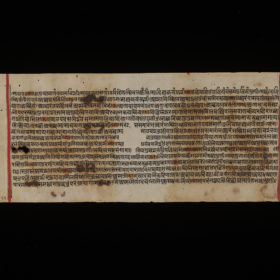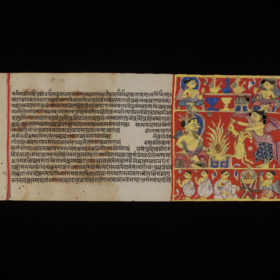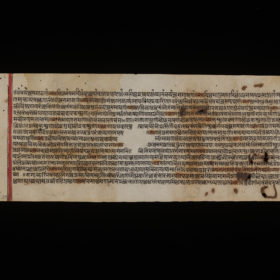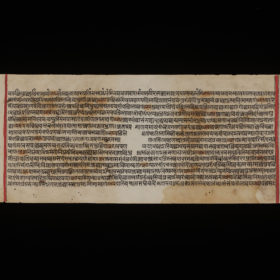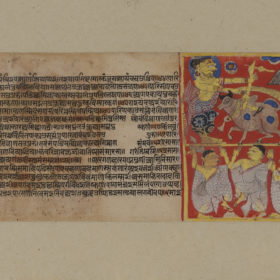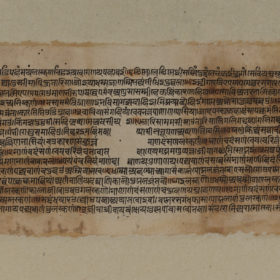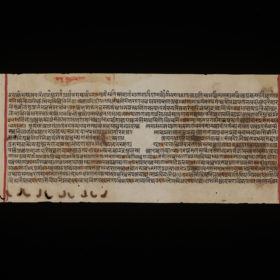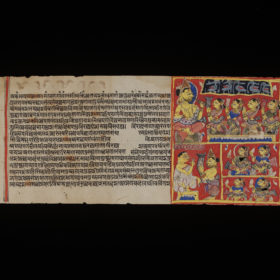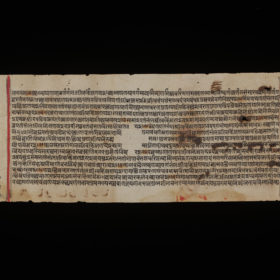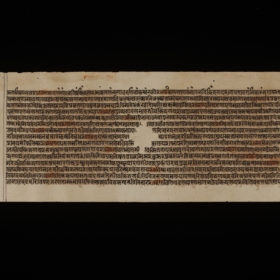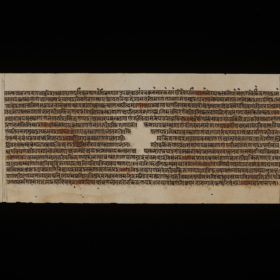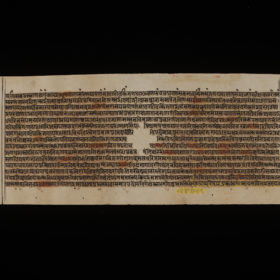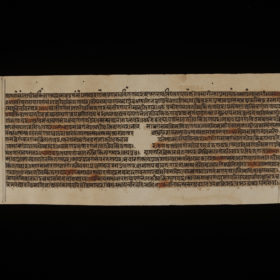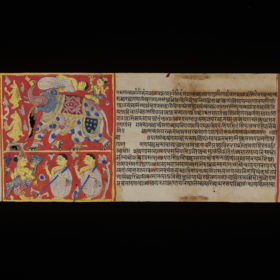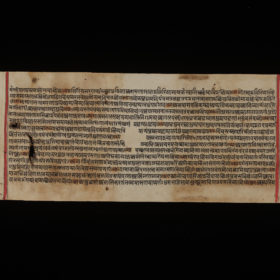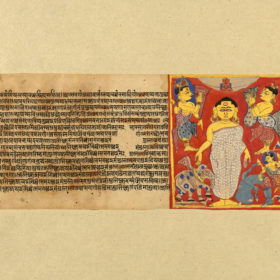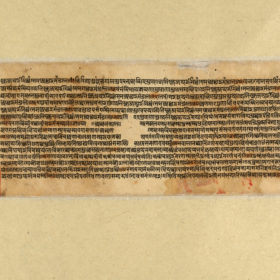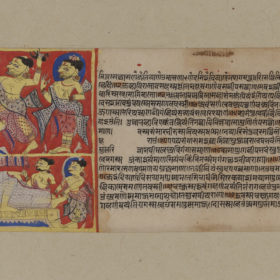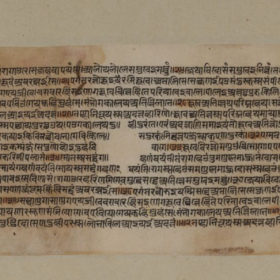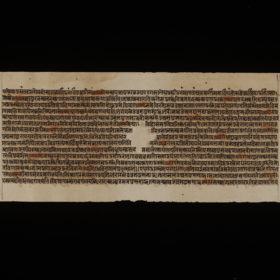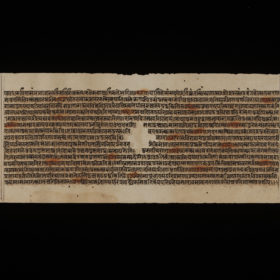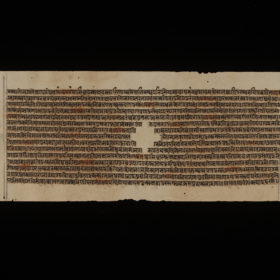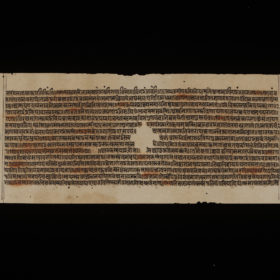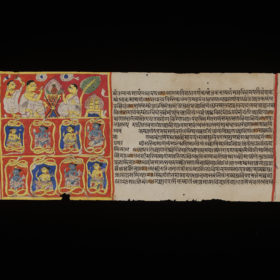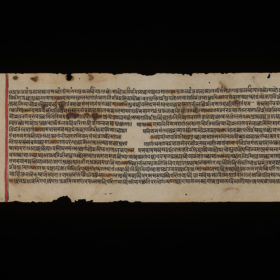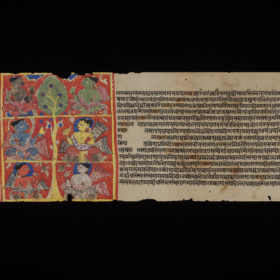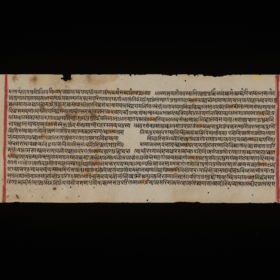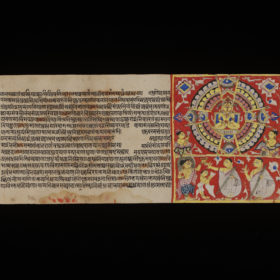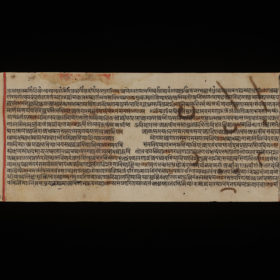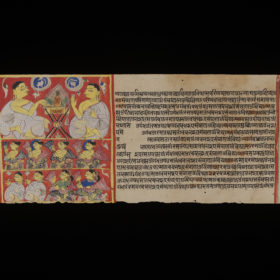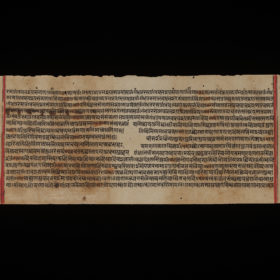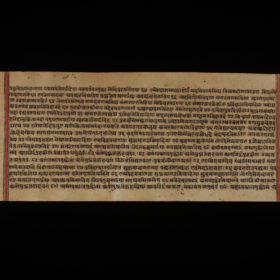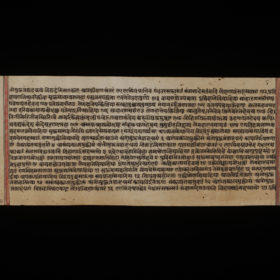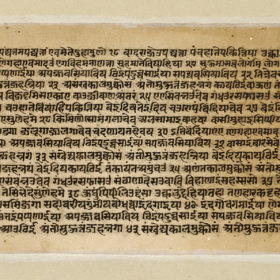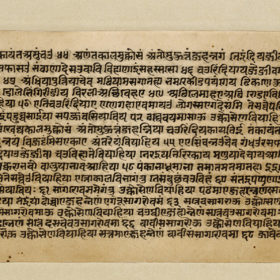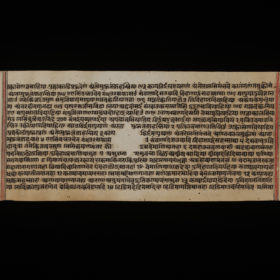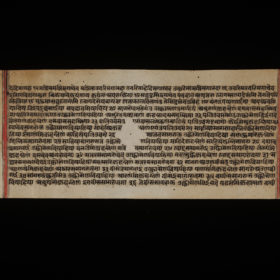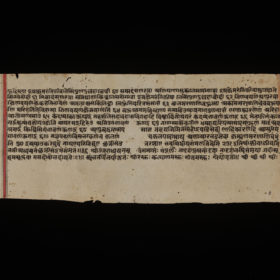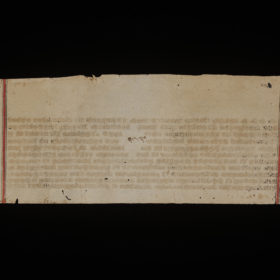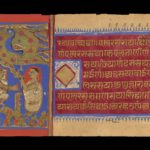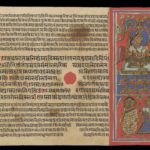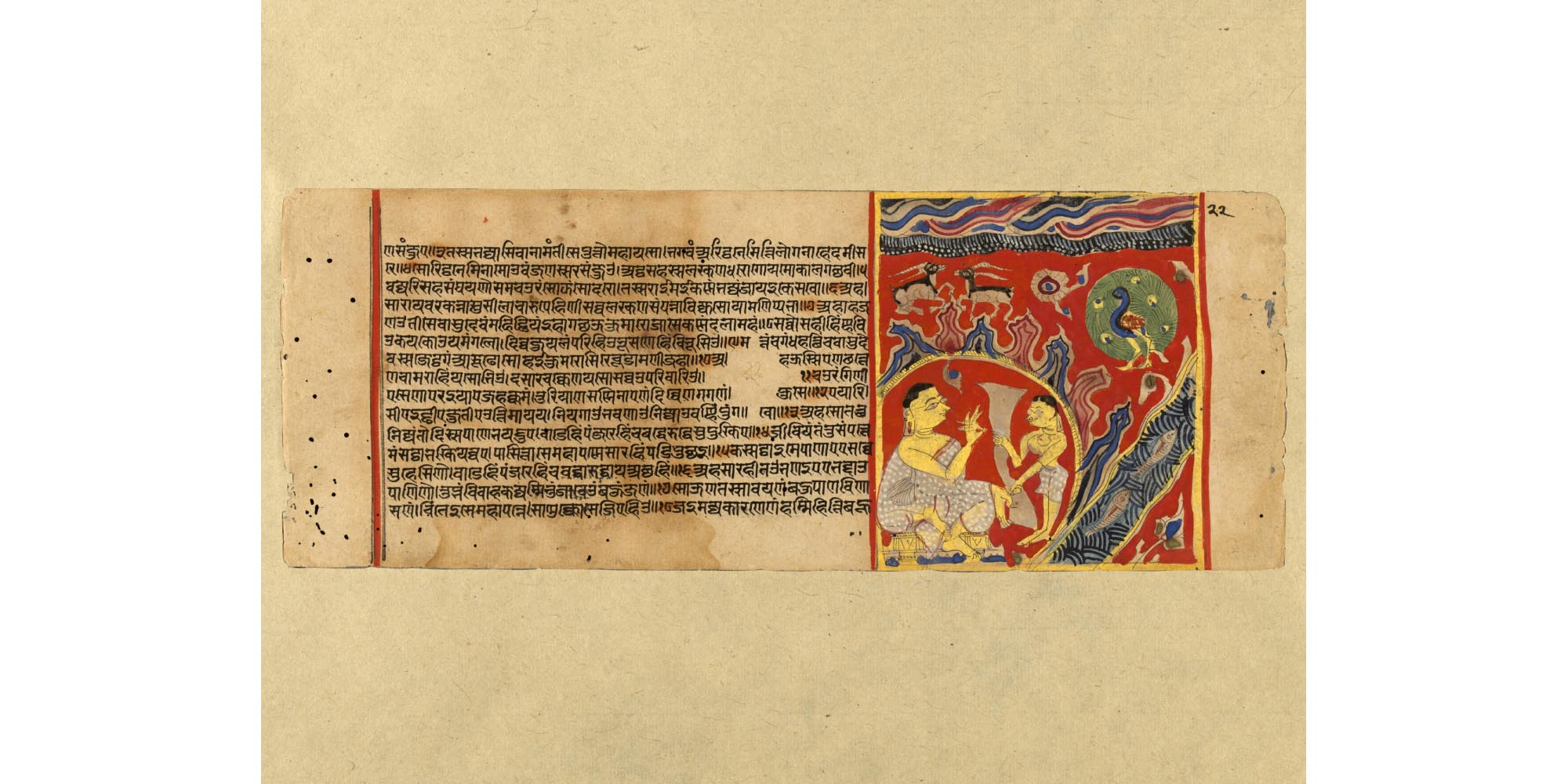
Background
This episode featuring Rājimatī and Rathanemi reminds Jains that even though it is hard to keep vows, even for ascetics, determination and spiritual focus can help overcome even the strongest temptations.
This tale is found in the Uttarādhyayana-sūtra, a scripture in the Śvetāmbara canon. It belongs to the class known as Mūla-sūtras, which include the most basic texts new mendicants learn at the beginning of their monastic education. It consists of didactic chapters, stories or parables and ascetic poetry teaching the fundamentals of Jainism. For instance, it opens with a chapter on the rules of respect and politeness that all monks have to observe, especially junior ones. It ends with an extensive chapter describing the rich world of living beings according to the Jain conception.
The Uttarādhyayana-sūtra is one of the most frequently illustrated texts.
Transcription
- ṇaṃ suhae //3 tassa bhajjā Sivā nāmaṃ tīse putto mahāyaso / bhagavaṃ Ariṭṭhanemi tti loganāhe damīsa
- re //4 so Riṭṭhanemināmo u vaṃjaṇassarasaṃjuo / aṭṭhasahassalakkhaṇadharo Goyamo kālagacchavī //5
- vajjarisahasaṃghayaṇo sama-cauraṃso jhasodaro / tassa Rāīmaī kannaṃ bhajjaṃ jāyai Kesavo //6 aha
- sā rāyavarakannā susīlā cārupehiṇī / savvalakkhaṇasaṃpannā vijjusoyāmaṇippabhā //7 ahāha ja
- ṇao tīse Vāsudevaṃ mahiḍḍhiyaṃ / ihāgacchaū kumāro jā se kaṇṇaṃ dalāmahaṃ //8 savvosahīhiṃ ṇhavi
- u kayakouyamaṃgalo / divvajuyalaṃ parihiu bhūsaṇehiṃ vibhūsio //9/ mattaṃ ca gaṃdhahatthiṃ Vāsude
- vassa jeṭṭhagaṃ / ārūḍho sohaī kumārā sire cūḍāmaṇī jahā //10 aha ussieṇa chatte
- ṇa cāmarāhiṃ ya sohio / dasāracakkeṇa ya so savvau parivārio //11 cauraṃgiṇī
- e/ seṇāe raiyāe jahakkamaṃ / turiyāṇaṃ sannināeṇaṃ divveṇa gagaṇaṃphuse //12 eyāri
- sīe iḍḍhīe jutīe uttimāyaya / niyagāo bhavaṇāo nijjāu vaṇhipuṃgavo //13 aha so tattha
- nijjaṃto dissa pāṇe bhayaddue / vāḍehiṃ paṃjarehiṃ ca baddhe ruddhe su-dukkhie //14 jīviyaṃtaṃ tu saṃpatte
- maṃsaṭṭhā bhakkhiyavvae / pāsittā se mahāpanne sārahiṃ paḍipucchai //15 kassaṭṭhā ime pāṇā ee savve
- suhesiṇo / vāḍehiṃ paṃjarehiṃ ca baddhā ruddhā ya acchahiṃ //16// aha sārahī tao bhaṇai ee bhaddā u
- pāṇiṇo / tubbhaṃ vivāhakajjammi bhuṃjāveuṃ bahuṃ jaṇaṃ //17 soūṇa tassa vayaṇaṃ bahupāṇaviṇāsaṇaṃ / ciṃtei se mahāpanne / sāṇukkose jiehi u //18 jai majjha kāraṇeṇaṃ hammaṃti bahū
Translation
His wife was Śivā by name; and her famous son was the venerable Ariṣṭanemi, the saviour of the world and the lord of ascetics. This Ariṣṭanemi, who was gifted with an excellent voice and possessed the thousand and eight lucky marks of the body, was a Gautama [family member], and his skin was black. His body was strong like that of a bull, and hard like steel; he was well proportioned, and had a belly like that of a fish. Keśava asked [for] the girl Rājimatī in marriage for him. Now this daughter of an excellent king was virtuous and well looking; she possessed all lucky marks of the body, and shone forth like the lightning Saudāmanī. Her father said to the powerful Vāsudeva: ‘Let the prince come here that I may give him my daughter.’
He [Nemi] had taken a bath containing all [lucky] herbs, and had performed the customary ceremonies; he wore a suit of heavenly clothes and was decked out with ornaments. Riding on the best elephant of Vāsudeva he looked beautiful, like a jewel worn on the head. He sat under a raised umbrella, fanned by two chowries [fly-whisks], and he was surrounded on all sides by a host of Daśārhas and by a complete army drawn up in rank and file, while the heavenly sound of musical instruments reached the sky.
With such pomp and splendour the hero of the Vṛṣṇis [= Prince Nemi] started from his own palace. On his way he saw animals kept in cages and enclosures, overcome by fear and looking miserable.
Seeing them on the point of being killed for the sake of their flesh, and to be eaten afterwards, the great sage spoke to his charioteer thus: ‘Why are all these animals, which desire to be happy, kept in cages and enclosures?’
Then the charioteer answered: ‘Lucky are these animals because at thy wedding they will furnish food for many people’.
Having heard these words, which announced the slaughter of many animals, the great sage, full of compassion and kindness to living beings, meditated thus: ‘If for my sake many [living beings are killed, I shall not obtain happiness in the next world.’
Then the famous man presented the charioteer with his pair of earrings, his neck-chain and all his ornaments].
translation by Hermann Jacobi (slightly modified)
Note that the text on this page does not match the illustration. The matching text is on the other side of the folio.
Glossary
Description
A man and a woman are inside a circular shape, which symbolises a cave. The seated man is dressed in the white robe of a Śvetāmbara monk. The alternating red and blue shapes round the circle’s perimeter stand for mountain peaks while natural scenery is suggested by the black and white deer and the river with fish swimming along it.
The peacock and the tormented sky along the top of the picture indicate that this episode takes place during the rainy season.
The Jain monk is Rathanemi, the elder brother of Neminātha, or Lord Nemi, the 22nd Jina, who is often called Ariṣṭanemi. Standing in front of him is the thin figure of a nun, who has removed her upper garment. This is Rājimatī. Once engaged to Nemi, she had decided to become a nun after he renounced worldly life on their wedding day.
Rājimatī goes towards Mount Raivataka and when it begins to rain she takes shelter in a cave, where she removes her clothes to dry them. Unknown to Rājimatī, Rathanemi is also in the cave and his mental peace is disturbed by the sight of her.
He invites her to love. But when Rājimatī tells him forcefully to behave nobly and remain strong in his asceticism, he is fully convinced by her spiritual strength.
Note that here the picture does not match the writing on the page. Instead, the episode is described on the verso of this folio.
Other visual elements
The number 22 in the top right-hand margin is the chapter number.
The blank diamond shape in the text is a simple ornamentation. It is the symbolic reminder of the hole through which the cord was passed in palm-leaf manuscripts.
Script
The elaborate script used for the main text is the Jaina Devanāgarī script, which recalls calligraphy. It is used for writing numerous Indian languages. Here it is used for Prakrit.
The characters covered with orange pigment are the verse numbers. They are at the end of each stanza, a reversal of the Western practice. The numbers on this page go from 3 to 18.
- Source:
Victoria and Albert Museum
- Shelfmark:
IS 2-1972
- Author:
unknown
- Date of creation:
circa 1450
- Folio number:
23 recto
- Total number of folios:
47, folio 25 missing
- Place of creation:
copied in Gulf of Cambay, Gujarat
- Language:
Ardhamāgadhī Prākrit
- Medium:
gouache and ink on paper
- Size:
30 x 11.5 cm
- Copyright:
V&A Images/Victoria and Albert Museum, London
- Image Copyright:
- +
- aAbhavya
- aAbhinandana
- aAbhiṣeka
- aĀcāra
- aĀcārāṅga-sūtra
- aĀcārya
- aAchalbhrata
- aAḍhāī-dvīpa
- aAdharma
- aAdho-loka
- aAdhyayana
- aAdvaita Vedānta
- aĀgama
- aAghātīya
- aAghātīya-karman
- aAgnibhuti
- aAgra
- aĀhāra
- aAhiṃsā
- aAhimsa Day
- aAjita
- aAjīva
- aAkampit
- aĀkāśa
- aAkbar the Great
- aAkṣaya-tṛtīyā
- aAlauddin Khalji
- aAlbert Einstein
- aAllah
- aAlms
- aĀlocanā
- aAloka-ākāśa
- aAmāri
- aAmbikā or Kūṣmāṇḍinī
- aAnagāra
- aAnanta
- aAnarthadaṇḍa
- aAnaśana
- aAnekānta-vāda
- aAṅga
- aAniconism
- aAnojjā
- aAntarāla
- aAntarāya-karma
- aAṇu
- aAṇu-vrata
- aAnukampā
- aAnuprekṣā
- aAnusvāra
- aApabhraṃśa
- aAparigraha
- aAra
- aĀrambha
- aĀrambhaja
- aĀratī
- aArdhamāgadhī Prākrit
- aArhaṃ
- aArhat
- aArśana-āvaraṇīya-karma
- aĀrta-dhyāna
- aĀryikā
- aĀryikā Jñānamati
- aĀśātanā
- aĀścarya
- aAscetic
- aAsceticism
- aAshram
- aAspiration
- aĀsrava
- aAṣṭa-maṅgala
- aAṣṭāpada
- aAstikāya
- aAstrolabe
- aAsura
- aAtheism
- aAticāra
- aAtiśayakṣetra
- aAtithisaṃvibhāgavrata
- aĀtma-vāda
- aĀtman
- aAuṃ
- aAurangzeb
- aAuspicious
- aAusterity
- aAvadhāna
- aAvadhi-jñāna
- aĀvaraṇī-yakarman
- aAvasarpiṇī
- aAvatāra
- aAvidyā
- aAxiom
- aĀyāga-paṭa
- aĀyambil
- aĀyu-karma
- aĀyurveda
- bBabur
- bBāhubali
- bBaladeva
- bBālāvabodha
- bBandha
- bBasadi
- bBazaar
- bBhadrankarvijay
- bBhagavant
- bBhaktāmara-stotra
- bBhakti
- bBhale
- bBharata
- bBhāṣā
- bBhāṣya
- bBhaṭṭāraka
- bBhāva
- bBhāva-pūjā
- bBhāvanā
- bBhavana-vāsin
- bBhavya
- bBhavyatva
- bBhaya
- bBhoga-bhūmi
- bBhogopabhoga
- bBodhi
- bBollywood
- bBrahmā
- bBrahma-deva
- bBrahmacārī
- bBrāhmaṇa
- bBraj Bhāṣā
- bBright fortnight
- bBritish Raj
- bBuddha
- bBuddhi-sagar
- bBuddhism
- bBuddhist
- cCaitya
- cCaityavāsin
- cCakravartin
- cCakreśvarī
- cCāmara
- cCandanā
- cCandragupta
- cCandraprabha
- cCanon
- cCāritra
- cCāritramohanīya-karman
- cCarũrī
- cCaste
- cCaturvidha-saṅgha
- cCaturviṃśati-stava
- cCāturyāma
- cCE
- cCelibacy
- cCha
- cChadmastha
- cChastity
- cCheda-sūtra
- cChristian
- cChristianity
- cClergy
- cCloning
- cColophon
- cCommentary
- cConch
- cConfession
- cCongregation
- cConsecration
- cCosmology
- cCremation
- cCrore
- cCult
- cCūrṇi
- dDādā-guru
- dDalit
- dDāna
- dDaṇḍa
- dDark fortnight
- dDarśana
- dDarśanamohanī-yakarman
- dDaśa-lakṣaṇa-parvan
- dDeity
- dDelhi Sultanate
- dDerāsar
- dDeśāvakāśika-vrata
- dDetachment
- dDevanāgarī
- dDevānandā
- dDevarddhi-gani
- dDevotee
- dDhamal
- dDhanuṣ
- dDhāra
- dDharma
- dDharma-dhyāna
- dDharma-sāgara
- dDharmastikaya
- dDhātakīkhaṇḍa
- dDholak
- dDhyāna
- dDiaspora
- dDig-vrata
- dDigambara
- dDīkṣā
- dDisciple
- dDīvālī
- dDivya-dhvani
- dDNA
- dDoctrine
- dDogma
- dDonor
- dDoṣa
- dDravya
- dDravya-pūjā
- dDrone
- dDuṣamā
- dDuṣamā-duṣamā
- dDuṣamā-suṣamā
- dDveṣa
- dDvīpa
- eEast India Company
- eEightfold Path
- eEkānta-vāda
- eEkendriya
- eElder
- eElders
- eEschatology
- eEtc up to
- fFarmān
- fFast
- fFatehpur Sikri
- fFestival
- fFestschrift
- fFiruz Shah
- fFly-Whisks
- fFolio
- fFour Noble Truths
- gGaccha
- gGaṇa
- gGaṇadhara
- gGanadharavada
- gGaṇeśa
- gGaṇin
- gGarba
- gGarbha
- gGarbha-gṛha
- gGaruḍa
- gGati
- gGene
- gGenomics
- gGhātī-yakarman
- gGhātīya
- gGhaznavid
- gGhiyasuddin Tughlaq
- gGhurid
- gGloss
- gGotra-karma
- gGujarāt
- gGujarati
- gGuṇa
- gGuṇa-sthāna
- gGuṇa-vrata
- gGupti
- gGuru
- gGuruṇī
- hHagiography
- hHajj
- hHaṃsa
- hHaribhadra
- hHariṇaigameṣin
- hHasta
- hHeresy
- hHiṃsā
- hHindi
- hHindu
- hHinduism
- hHīravijaya
- hHoroscope
- hHrīṃ
- hHumayun
- hHymn
- iIconoclasm
- iIconography
- iIdol
- iIndian Independence
- iIndology
- iIndra
- iIndrabhūti Gautama
- iIndriya
- iInitiation
- iIntercession
- iInvocation
- iIQ
- iIslam
- iIslamicate
- iIṣṭadevatā
- iĪśvara
- jJagat
- jJahangir
- jJain
- jJaina Devanāgarī
- jJaina Śaurasenī
- jJaina-dharma
- jJainaśāsana
- jJainness
- jJaisalmer
- jJamāli
- jJambū-dvīpa
- jJames Burgess
- jJanma
- jJanma-kalyāṇa
- jJarā
- jJāti
- jJina
- jJina-āgama
- jJina-bhavana
- jJina-bimba
- jJina-mātā
- jJinacandra-sūri
- jJinadatta
- jJinaprabha
- jJīva
- jJñāna
- jJñāna-āvaraṇīya-karma
- jJñāna-āvarṇiya
- jJñānsundar
- jJyotiṣka
- kKāla
- kKālakācārya-kathā
- kKālidāsa
- kKalpa-sūtra
- kKalpa-vṛkṣa
- kKalyāṇaka
- kKalyanvijay
- kKamaṇḍalu
- kKamaṭha
- kKarma
- kKarma-bhūmi
- kKarma-grantha
- kKarma-prakṛti
- kKarma-vāda
- kKarmon
- kKarnataka
- kKaṣāya
- kKathā
- kKāvya
- kKāya
- kKāyotsarga
- kKeśa-loca
- kKetu
- kKevala-jñāna
- kKevalin
- kKhalji
- kKharatara-gaccha
- kKnowledge
- kKriyā
- kKriyā-vāda
- kKṛṣṇa
- kKṣamā-śramaṇa
- kKṣapakaśreṇi
- kKṣatriya
- kKṣullaka
- kKulakara
- kKundakunda
- kKunthu
- lLabdhi
- lLaity
- lLakh
- lLāñchana
- lLands of Action
- lLaukāntika
- lLavaṇa-samudra
- lLeśyā
- lLiṅga
- lLinguistics
- lLoka
- lLoka-ākāśa
- lLoka-puruṣa
- lLoka-vāda
- lLotus
- lLotus lake
- mMadhya-loka
- mMahā-videha
- mMahā-vrata
- mMahābhārata
- mMahāmastakābhiṣeka
- mMāhārāṣṭra
- mMāhārāṣṭrī Prākrit
- mMahattarā Yākinī
- mMahāvīr Jayantī
- mMahāvīra
- mMakāra
- mMakkhali Gośāla
- mMalli
- mMāna-stambha
- mManaḥ-paryāya-jñāna
- mMaṇḍala
- mMaṇḍapa
- mMandit
- mMaṅgala
- mMantra
- mMantras
- mManuṣya-loka
- mMarāṭhī
- mMārgaṇā
- mMartyr
- mMarudevī
- mMaṭha
- mMati-jñāna
- mMauryaputra
- mMecca
- mMendicant lineage
- mMetarya
- mMiracle
- mMithyādṛṣṭi
- mMohandas Gandhi
- mMohanīya-karma
- mMokṣa
- mMonastic order
- mMonasticism
- mMonk
- mMonotheism
- mMosque
- mMount Meru
- mMount Sammeta
- mMṛgāvatī
- mMughal
- mMuhammad
- mMuhammad bin Tughlaq
- mMuhpattī
- mMūla-sūtra
- mMūlaguṇa
- mMumbaī
- mMuni
- mMunisuvrata
- mMurad Bakhsh
- mMūrti-pūjaka
- mMuslim
- mMysticism
- nNābhi
- nNāga-kal
- nNāgapurīya Tapā-gaccha
- nNāgarī
- nNāma-karma
- nNamaskāra-mantra
- nNami
- nNandīśvara-dvīpa
- nNandivardhana
- nNandyāvarta
- nNāraka
- nNāraki
- nNasalisation
- nNātha
- nNavrātrī
- nNaya-vāda
- nNemi
- nNidāna
- nniggaṃthāṇa vā 2
- nniggaṃtho vā 2
- nNigoda
- nNihnava
- nNikṣepa
- nNirgrantha
- nNirjarā
- nNirvāṇa
- nNiryukti
- nNiṣidhi
- nNitya
- nNiyati
- nNo-kaṣāya
- nNudity
- nNun
- oOcean of milk
- oOmniscience
- oOrdination
- ppa°
- pPadmaprabha
- pPadmāsana
- pPadmāvatī
- pPādukā
- pPalanquin
- pPalette
- pPañca-muṣṭi
- pPāṇḍava
- pPaṇḍit
- pPandit Dalsukh D. Malvania
- pPandit Sukhlalji
- pPāṇipātra
- pPāpa
- pParamātman
- pParameṣṭhin
- pPāraṇā
- pParigraha
- pPariṇāma
- pParīṣaha
- pParokṣa
- pPārśva
- pPārśvanātha
- pParyāya
- pParyuṣaṇ
- pPaṭa
- pPatan
- pPātra
- pPenance
- pPersian
- pPhala
- pPhilology
- pPicchikā
- pPilgrimage
- pPīr
- pPolymath
- pPoṣadha
- pPossession
- pPothī
- pPrabhas
- pPradakṣiṇā
- pPradeśa
- pPrākāra
- pPrakīrṇaka-sūtra
- pPrākrit
- pPramāda
- pPramukhā
- pPrati-vāsudeva
- pPratikramaṇa
- pPratimā
- pPratiṣṭhā
- pPratyākhyāna
- pPratyakṣa
- pPravacana
- pPrāyaścitta
- pPrayer
- pPre-modern
- pPreach
- pPredestination
- pProtestant
- pProvenance
- pPudgala
- pPūjā
- pPujārī
- pPukharavara-dvīpa
- pPuṇya
- pPūrva
- pPuṣkara-dvīpa
- pPuṣpadanta
- pPyre
- qQur’an
- rRāga
- rRāhu
- rRainy season
- rRajasthan
- rRajasthani
- rRājimatī
- rRajoharaṇa
- rRajput
- rRāma
- rRāmāyaṇa
- rRangoli
- rRās-garbā
- rRasa
- rRathanemi
- rRatna-traya
- rRātri-bhojana
- rRaudra-dhyāna
- rRecto
- rRelic
- rRenunciation
- rRetroflex
- rRevatī
- %Ṛg-veda
- rRite
- rRosary
- %Ṛṣabha
- %Ṛṣabhanātha
- rRupee
- sSaciyā Mātā
- sSādhu
- sSādhvī
- sSāgāra
- sSaint
- sŚaivaism
- sŚaka-saṃvat
- sSallekhanā
- sŚalya
- sSamacatuṣṭha
- sSamādhimaraṇa
- sSamaṇi
- sSāmarambha
- sSamavasaraṇa
- sSāmāyika
- sSaṃbhava
- sSamiti
- sSaṃjñā
- sSaṃkalpaja
- sSaṃsāra
- sSamudghāta
- sSaṃvara
- sSaṃvega
- sSamyak-cāritra
- sSamyak-darśana
- sSamyak-jñāna
- sSamyaktva
- sSaṃyama
- sSanctuary
- sSandalwood
- sSaṇgha
- sSanskrit
- sSant
- sŚānti
- sSapta-bhaṅgi-naya
- sSārambha
- sSarasvatī
- sSarvajña
- sSāsan-devi
- sŚāsana-devatā
- sŚāstra
- %Ṣaṭ-jīvanikāya
- sSatī
- sSatīmātā
- sSatya
- sSchism
- sScribe
- sScripture
- sSect
- sSecularism
- sŚenāī
- sSermon
- sŚeṣavatī
- sSevā
- sSeven fields of donation
- sShah Jahan
- sShantidas Jhaveri
- sShrine
- sSiddha
- sSiddha-śilā
- sSiddhacakra or Navadevatā
- sSiddhānta
- sSiddhārtha
- sSiddhi
- sSikh
- sSikhism
- sŚikṣā-vrata
- sŚīla
- sSin
- sSindh
- sŚītala
- sŚiva
- sSkandha
- sSomanatha
- sŚraddhā
- sŚramaṇa
- sŚrāvaka
- sŚrāvakācāra
- sŚrāvikā
- sŚreyāṃsa
- sŚrī
- sŚrīvatsa
- sŚruta-jñāna
- sŚruta-pañcamī
- sSthānaka-vāsin
- sSthāpanācārya
- sSthāvara
- sSthavira
- sSthiti
- sStrīmukti
- sStūpa
- sSubcontinent
- sSudarshana
- sŚuddhi
- sSudharma
- sŚūdra
- sSufism
- sSukha
- sŚukla-dhyāna
- sSulasā
- sSultan
- sSumati
- sSundarśrī
- sSupārśva
- sSūri
- sSuṣamā
- sSuṣamā-duṣamā
- sSuṣamā-suṣamā
- sSūtra
- sSuyam me ausam! Tenam bhagavaya evamakkhayam
- sSvādhyāya
- sSvāhā
- sSvastika
- sŚvetāmbara
- sŚvetāmbara Terāpanthin
- sŚvetāmbaras
- sSwan
- sSyād-vāda
- tTabla
- tTantra
- tTapā-gaccha
- tTapas
- tTāraṇ Svāmī Panth
- tTattva
- tTattvārtha-sūtra
- tTemple
- tTemple-city
- tThe Enlightenment
- tTheology
- tThree worlds
- %Ṭīkā
- tTilaka
- tTīrtha
- tTīrthaṃkaranāma-karman
- tTīrthankara
- tTransliteration
- tTrasa
- tTrasa-nāḍī
- tTriśalā
- tTriṣaṣṭi-śalākā-puruṣa-caritra
- tTti bemi
- tTughlaq
- tTunk
- uUdumbara
- uUniversal History
- uUpādhyāya
- uUpāṅga
- uUpaniṣads
- uUpāsaka
- uUpasarga
- uUpāśraya
- uŪrdhva-loka
- uUtsarpiṇī
- uUttarādhyayana-sūtra
- vVāhana
- vVaimānika
- vVairāgya
- vVaiṣṇava
- vVaiśramaṇa
- vVaiśya
- vValabhī
- vVanaspatikāya
- vVandana
- vVaṇik
- vVarṇa
- vVāsudeva
- vVāsupūjya
- vVayubhūti
- vVeda
- vVedanīya-karma
- vVegetarianism
- vVehicle
- vVernacular
- vVerso
- vVidyā
- vVidyā-devī
- vVihāra
- vVijñapti-patra
- vVikrama-saṃvat
- vVikṛti
- vVimala
- vVinaya
- vVipāka
- vVirji Vora
- vVirodhaja
- vVīrya
- vVisarga
- vViṣṇu
- vVītarāga
- vVizier
- vVotive
- vVow
- vVrata
- vVS
- vVyakta
- vVyantara
- vVyasana
- yYakṣa
- yYakṣī
- yYantra
- yYaśoda
- yYaśovijaya
- yYati
- yYātrā
- yYoga
- yYoginī
- yYojana
Description
A man and a woman are inside a circular shape, which symbolises a cave. The seated man is dressed in the white robe of a Śvetāmbara monk. The alternating red and blue shapes round the circle’s perimeter stand for mountain peaks while natural scenery is suggested by the black and white deer and the river with fish swimming along it.
The peacock and the tormented sky along the top of the picture indicate that this episode takes place during the rainy season.
The Jain monk is Rathanemi, the elder brother of Neminātha, or Lord Nemi, the 22nd Jina, who is often called Ariṣṭanemi. Standing in front of him is the thin figure of a nun, who has removed her upper garment. This is Rājimatī. Once engaged to Nemi, she had decided to become a nun after he renounced worldly life on their wedding day.
Rājimatī goes towards Mount Raivataka and when it begins to rain she takes shelter in a cave, where she removes her clothes to dry them. Unknown to Rājimatī, Rathanemi is also in the cave and his mental peace is disturbed by the sight of her.
He invites her to love. But when Rājimatī tells him forcefully to behave nobly and remain strong in his asceticism, he is fully convinced by her spiritual strength.
Note that here the picture does not match the writing on the page. Instead, the episode is described on the verso of this folio.
Other visual elements
The number 22 in the top right-hand margin is the chapter number.
The blank diamond shape in the text is a simple ornamentation. It is the symbolic reminder of the hole through which the cord was passed in palm-leaf manuscripts.
Script
The elaborate script used for the main text is the Jaina Devanāgarī script, which recalls calligraphy. It is used for writing numerous Indian languages. Here it is used for Prakrit.
The characters covered with orange pigment are the verse numbers. They are at the end of each stanza, a reversal of the Western practice. The numbers on this page go from 3 to 18.





























































































